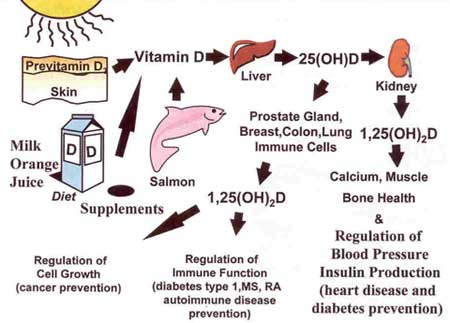
Vitamin D Deficiency Symptoms – Why is it Bad to Have a Vitamin D Deficiency?
Vitamin D Deficiency Symptoms
Vitamin D is very important in most areas of human health, including the absorption of phosphorus and calcium from food. Vitamin D deficiency symptoms are capable of negatively affecting the growth and development of cells, teeth, bones and regulation of hormones. The symptoms can also affect the immune system and nervous system. The deficiency takes place when there is insufficient exposure to the sun, which leads to the body’s inability to absorb vitamin D or its absence in the food eaten. The symptoms can also be caused by the inability of the body to absorb and use Vitamin D, in addition to other abnormal metabolic and digestive processes.
There are many ways through which Vitamin D can be absorbed by the body. One way that most people know about is when the skin is exposed to the sun. According to many researchers, your body can get enough vitamin D when you expose your body to the sun for as little as 15 minutes. However, some other ways are through foods high in vitamin D like eggs, fish, cod liver oil and fortified milk. Another good source is when you take a multivitamin daily.
There are many benefits of vitamin D, to such an extent that medical professionals call it the “super nutrient”. It is capable of helping you reduce the risk of different health problems, including some cancers and autoimmune diseases, multiple sclerosis, rheumatoid arthritis, Type I diabetes and many others. On cancers, the vitamins can help in reducing the risk of cancers like colon, breast, lungs, and blood in elderly women. It can also be very powerful in fighting tuberculosis.
In elderly people, it can also be very useful. For instance, it can reduce the risk of bone loss and increase bone mineral density below 70 years. Oral supplements of vitamin D can also help in relieving osteomalacia pain, that is always wrongly diagnosed as fibromyalgia, and when you use them in the correct way, they can help in treating psoriasis.
Vitamin D Deficiency Symptoms in Infants and Adults
Vitamin D deficiency symptoms in infants are generally different than adults:
1. Infants: In the case of infants, the symptoms can show up as bone deformity or rickets. Rickets occurs when the infant is about six months of age. They can present with issues like growth retardation, skeletal deformities, including knocked knees or bowing of the legs, prominent knob such as projections on the ribs close to the sternum, known as muscle weakness and the rachitic rosary. Infants having vitamin D deficiency can also suffer from craniotabes, which is the softening of the skull making it to be square-shaped. They also develop an increase in the bone formation on the forehead, also referred to as known as frontal bossing.
2. Adults: In adults, the presence of Vitamin D deficiency symptoms shows evidence that some complex diseases are already present or in developing stages. Some of the symptoms are:
– poor immune system. This is likely to lead to upper respiratory infection, recurrent viruses and many other infections.
– Osteoporosis as a result of malabsorption of Calcium.
– Mood changes in the form of seasonal depression and other mood disorders.
– Development of heart problems and high blood pressure.
– Development of chronic diseases like Crohn’s disease, Multiple Sclerosis and other auto-immune disorders.
– Development of dental problems and gum disease through malabsorption of Calcium
– Sudden development of Asthma or worsening Asthma symptoms.
– Bone disease development called osteomalacia. The condition in which the bone becomes soft is called Osteomalacia.
Vitamin D deficiency symptoms
Vitamin D is known as the “sunshine vitamin”
All Vitamin D deficiency symptoms do not relate to the function of the bone. The individual’s emotional health may also be affected. Depression and anxiety can be exacerbated or caused by the lack of vitamin D because it is very useful in the creation of building blocks, which produce the neuro-transmitters which help in maintaining emotional balance. For instance, Seasonal Affective Disorder is a type of depression, which is common during cold weather, is likely to be caused by the absence of vitamin D and other important nutrients. The reason for this is that one important source of Vitamin D is when the skin is exposed to sunlight (as said above), an important thing that is lacking in many people when they remain indoors during winter.
Some people have higher risk of suffering from Vitamin D deficiency
The people with high risk of suffering from Vitamin D deficiency symptoms are dark-skinned people, elderly people and obese people. However, you should still try to maintain the right Vitamin D level in your body even if you do not fall into these categories. For most people below 50 years, the correct Vitamin D intake is 5mcg (200IU) everyday. For those older than 50 years, the correct intake is 10 mcg (400IU) everyday. This is a very simple way of maintaining the correct Vitamin D level in your body. However, if you are not sure of the right level for you, it is important to talk to a doctor since the need of Vitamin D may vary from one person to another and your daily dosage of Vitamin D will need to be tailored to your needs.